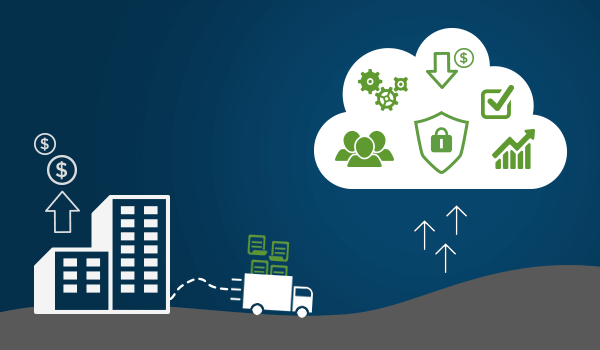In today’s rapidly and constantly evolving digital landscape, businesses must continuously look for ways to stay agile and competitive. Cloud elasticity is one of the primary tools that has risen to help these organizations accomplish this.
Cloud elasticity is a fundamental concept in cloud computing services that enables organizations to scale their resources up or down according to demand dynamically. This article will provide an in-depth look into the fundamentals of how cloud elasticity works in cloud platforms and what that means for businesses.
It will also delve into its advantages to shed light on why it has become a crucial component of modern IT infrastructure, as well as its disadvantages to help you mitigate them.
What is Cloud Elasticity?
Within the immense ecosystem of cloud services such as Microsoft Azure, Google Cloud, and AWS is a concept known as cloud elasticity. This concept stands out as a fundamental enabler of efficiency and flexibility. Cloud elasticity, also known as auto-scaling, refers to a core feature of cloud computing platforms that enables organizations to change their computing resources based on real-time workload changes dynamically.
Unlike cloud scalability, which entails meeting the static increase in workload demands, cloud elasticity entails meeting dynamic changes, where the need for resources can increase or decrease.
It is the concept of having an organization’s cloud infrastructure automatically contract or expand as needed to ensure optimal resource allocation, performance, and cost-effectiveness. Elasticity is a fundamental characteristic of cloud computing and a core component of the as-a-service, or aaS, model, specifically in Infrastructure as a Service (IaaS) and Software as a Service (SaaS).
Think of it as a rubber band that contracts and stretches according to how much tension you apply. Within the cloud environments, your existing infrastructure can stretch to accommodate high demand and contract during periods of decreased activity to ensure you do not over-provision resources and incur unnecessary costs.
To better comprehend cloud elasticity, one must understand its underlying principles. These principles include on-demand resource allocation, automated trigger mechanisms, vertical and horizontal scaling, and a pay-per-use model.
On-demand provisioning
On-demand provisioning refers to a fundamental principle of cloud elasticity which deals with allocating resources whenever necessary, which is why some refer to it as on-demand resource allocation.
This principle entails that you can instantly allocate additional network resources, computing power, or storage capacity whenever a surge in demand occurs. Similarly, when the market reduces, you can release said resources to minimize costs.
Automated scaling
Cloud elasticity is heavily reliant on automation. Intelligent policies and algorithms keep tabs on resource usage and trigger scaling events as needed to reduce the need for manual intervention.
This automation ensures that applications can maintain performance without constant monitoring, adjustments, and modifications.
Resource pools
Cloud service providers maintain enormous resource pools that are accessible to their users. These pools include storage, networking components, and virtual machines.
Elasticity takes advantage of these pools to allocate resources as needed to ensure users have access to said resources without requiring upfront provisioning.
Pay-Per-Use-Model
Elasticity aligns with the pay-per-use billing model, which means users only get charged for the resources they use during peak demand periods. This model makes it a cost-effective solution compared to more traditional on-premises infrastructure which entails provisioning cloud resources in advance.
Pros of Cloud Elasticity
Now that you better understand how cloud elasticity works, it is time to delve into the benefits. Here is a list of substantial advantages cloud elasticity brings to individuals and businesses across various industries and sectors.
1. Cost optimization
Cost optimization is one of the most compelling advantages of cloud elasticity, as it enables organizations to avoid over-provisioning resources that can lead to unnecessary costs. By dynamically scaling resources to keep up with demand, organizations gain the ability to optimize their spending, enabling them to pay only for resources they utilize at any given time.
This level of flexibility can result in substantial cost savings, especially when compared to traditional infrastructure, where excess capacity typically lies dormant and wasted.
2. Improved performance
Elasticity plays a critical role in ensuring the consistency of application performance. When traffic spikes occur because of sudden surges in demand or user activity, cloud elasticity enables applications to scale up their resources to handle the increased load seamlessly.
This dynamic scaling ensures the application maintains availability and responsiveness to deliver an exceptional user experience despite peak usage periods.
3. Enhanced reliability
The reliability of services and applications is a critical concern for businesses, and cloud elasticity contributes massively to boosting reliability. Cloud elasticity minimizes the risk of outages or performance degradation during peak usage to ensure that critical services and applications remain available and perform optimally.
This increase in reliability is a significant factor in maintaining customer satisfaction and trust.
4. Quick response to market changes
The business landscape is consistently and rapidly evolving, which makes it a requirement for businesses to adapt promptly to shifting market conditions. Cloud elasticity empowers organizations to respond quickly to market shifts by scaling their resources up or down in real time.
This agility allows these organizations to address challenges, stay competitive, and seize opportunities in a constantly evolving environment.
5. Resource efficiency
Elasticity supports resource efficiency by ensuring optimal resource utilization, eliminating the need for manual adjustments, and constant resource provisioning. Organizations can maximize resource utilization by dynamically allocating resources based on demand to reduce wastage.
This aligns with green IT initiatives and results in cost savings to promote sustainability.
6. Business continuity
Ensuring their business continuity is a high priority for organizations, and cloud elasticity can provide the infrastructure needed to support business continuity and disaster recovery plans. In a disruption or failure, cloud elasticity enables the quick deployment of backup resources to minimize data loss and downtime.
7. Flexibility and experimentation
Innovation often requires experimentation, and cloud elasticity can provide a flexible environment for testing innovations and ideas. Organizations can rapidly experiment with new features, conduct A/B testing, and spin up test environments without significant upfront investment in infrastructure.
This flexibility can accelerate the development and deployment of new services and solutions.
8. Global reach
For organizations with a global presence or aspirations, cloud elasticity provides the benefit of rapidly expanding into new markets or regions. Cloud providers have distributed data centers worldwide, allowing organizations to deploy resources closer to their target audiences, reducing latency and enhancing the user experience for customers worldwide.
9. Predictive analytics
Elasticity does not only react to current demand but can also be utilized proactively through predictive analytics. Companies can forecast future resource requirements by analyzing historical usage trends and patterns and proactively scale their infrastructure to meet the predicted demand.
This predictive approach further boosts performance and cost efficiency.
10. DevOps and continuous integration/continuous deployment or CI/CD
Cloud elasticity is a natural fit for DevOps practices and continuous integration/deployment or CI/CD pipelines, which enable developers to rapidly build, test, and deploy applications in a scalable and automated environment. It streamlines the development process, facilitates faster time-to-market of new features and updates, and shortens release cycles.
Cons of Cloud Elasticity
While cloud elasticity offers several significant benefits, it is not free from its fair share of challenges and considerations. It is essential to learn about these drawbacks in order to make informed decisions about getting around them.
1. Cost management complexity
While cloud elasticity can help reduce costs, it can also introduce challenges in cost management, such as variable costs, underutilization, and cost monitoring. Organizations must carefully monitor and optimize resource usage to avoid unexpected expenses.
2. Vendor lock-in
Vendor lock-in is when a customer becomes too dependent on a specific vendor’s products, technologies, or services. This level of dependence has reached the extent where it is costly or difficult to switch to an alternative solution or vendor.
Over-reliance on one cloud provider’s elasticity features can lead to vendor lock-in, which makes it challenging to adopt a multi-cloud strategy or switch providers.
3. Latency concerns
Latency issues in cloud elasticity are critical when managing elastic cloud-based systems. Latency is the delay or time it takes for data to travel between the source and the destination in a networked system.
In cloud elasticity, latency concerns significantly impact your applications’ performance and user experience. Some primary aspects of latency concerns in cloud elasticity include resource scaling latency, data transfer latency, and microservices communication.
4. Security and compliance
Cloud elasticity introduces complex security and compliance challenges such as identity and access management, or IAM; data security and privacy; and compliance management. Businesses must ensure they properly secure resources and meet the necessary compliance requirements as they scale up and down.
5. Operational challenges
Despite offering significant advantages in flexibility and scalability, cloud elasticity also presents operational challenges such as performance monitoring, capacity planning, and logging and debugging.
This is because implementing and managing elastic resources requires a significant change in operational practices. This shift makes monitoring tools and automation critical to ensuring the effective utilization of resources.
The Purpose of Cloud Elasticity
Since cloud elasticity allows businesses to dynamically adjust their computing resources in real time in order to meet changing demands, its use cases and capabilities have far-reaching implications across various industries. Here are some of the most well-known practical applications of cloud elasticity that cover a variety of industries, from finance and healthcare to media and gaming.
E-commerce and retail
E-commerce platforms often experience massive fluctuations in web traffic, especially during promotional events or holiday seasons. Cloud elasticity allows these businesses to scale their infrastructure to accommodate surges in traffic and ensure a seamless shopping experience for their customers.
One excellent example is the public cloud solution Amazon Web Services, or AWS, which provides Auto Scaling that automatically adjusts the number of web servers to facilitate varying levels of web traffic.
Media and entertainment
Streaming services like Netflix, Disney+, and Amazon Prime Video rely heavily on cloud elasticity to simultaneously deliver content to millions of viewers. By dynamically scaling their server capacity according to viewer demand, these platforms ensure seamless streaming experiences without over or under-provisioning resources regardless of peak hours.
Healthcare
In the healthcare industry, cloud elasticity plays a crucial role in handling data-intensive tasks, such as genomic analysis and medical image processing. Research institutions and hospitals can scale their computing resources when needed to more efficiently diagnose illnesses, provide better patient care, and accelerate research.
Finance
Financial institutions require high-performance computing for fraud detection, algorithmic trading, and risk assessment. Cloud elasticity allows these institutions to allocate additional computational resources during peak trading hours and scale down when demands are quiet to optimize costs while maintaining responsiveness.
Gaming
The gaming industry has witnessed a change toward cloud-based gaming platforms like Microsoft’s Project xCloud and Google Stadia. Cloud elasticity ensures that players experience low-latency gameplay by dynamically allocating computing power based on real-time demand to reduce the need for upgrading high-end gaming hardware like top-of-the-line CPUs and GPUs.
Startups and small businesses
Elastic computing is a game-changer for small businesses and startups that need to compete with larger enterprises despite their limited resources. It enables them to scale their existing infrastructure as their user base grows without making massive upfront investments in data servers or centers.
Reap the Benefits of Cloud Elasticity
Cloud elasticity has become a fundamental aspect of modern IT infrastructure and an invaluable asset to IT managers by providing numerous advantages to organizations seeking to remain agile, cost-effective, and responsive to changing demands. However, it is not without its challenges, including the potential for vendor lock-in, cost management complexity, and security concerns.
Businesses must carefully plan, automate, and monitor their elastic computing resources to reap the benefits of cloud elasticity while mitigating the drawbacks. By doing so, they can optimize costs, enhance reliability, and support innovation in an increasingly dynamic and competitive digital landscape.
Follow Techdee for more!






